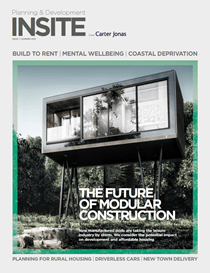A failure of the planning system to assess rural housing need based on changing social and technological criteria is leaving English villages trapped in the analogue age, according to the CLA. Planning & Development Insite spoke to its president, Tim Breitmeyer, about its revealing report.
Recent research has shown that the average age of someone relocating from the city to the countryside has, for the first time, fallen below 40. Village life is increasingly appealing to families looking for a healthier lifestyle, a sense of community and more space. Also, to the increasing number of small business owners and homeworkers.
But while social trends demand more rural housing, the system is failing to deliver – and consequently rural house prices remain out of reach for many, further exacerbating the rural housing crisis and, in some areas, a bucolic stagnation is taking place.
Tim Breitmeyer is the President of the Country Land and Business Association (CLA). The organisation recently produced a report Sustainable Villages – Making rural communities fit for the future, which demonstrates that over 2,000 villages are unable to provide new housing because they are technically classified as unsuitable for additional homes.
“The problem,” Breitmeyer says, “is outdated sustainability assessments and a static approach to rural planning. We researched the Local Plans of 70 local authorities in England described as “mainly rural” by the ONS, and found that 2,154 villages are judged to be unsustainable. In these communities, housing allocation, including the delivery of affordable homes, is either highly restricted or not permitted.”
The research found that Cornwall has the most villages deemed unsustainable, at 213, followed by Wiltshire at 168 and Central Lincolnshire at 132.
The CLA investigated the settlement hierarchy that local authorities use when allocating development, which scores villages against a range of services and amenities. Only 18% featured broadband and, as such, the potential to work, shop and or order prescriptions online was omitted from the hierarchy.
For too long, villages have fallen into the sustainability trap.
The CLA is calling on the Government to address the housing needs of those communities deemed unsustainable for development by carrying out mandatory housing needs assessments to improve the understanding of the rural housing crisis.
“In practice, housing allocation is a trickle-down process. Sites are allocated to villages high up the settlement hierarchy, with remaining villages only able to utilise small-scale infill development, redevelopment, building conversions within existing boundaries, rural exception sites or entry level exception sites to create new homes. In many cases, the unintended consequence is to change the often dispersed layout, and with it the charm, of so many of our villages.”
While many villagers are understandably opposed to large-scale developments on their doorstep, it shouldn’t be assumed that they are anti-growth. Organic growth is necessary to ongoing sustainability. Most rural communities want to be in a position to provide homes for young families and to keep shops and pubs open, and bus routes running.
Furthermore, the current system lacks foresight. “Rather than simply assessing villages for the services they have now, the question we should be asking is, what do we want those communities to look like in the next two decades or more, and how can we work to achieve this? The starting point has to be the people who live and work there, and the future economy. Future services and businesses will choose to locate in areas with robust and diversified economies. These areas will then attract higher paid jobs which will help reduce the indifference between house prices and salaries.
“While a strong economy is the only long-term solution to the rural housing crisis, there are steps that need to be taken now to address the loss of young people to towns and cities, the reduction in social capital as people are priced out of an area, and the environmental cost of commuting.”
While many villagers are understandably opposed to large-scale developments on their doorstep, it shouldn’t be assumed that they are anti-growth.
Public transport is a key issue. The majority of the local authority documents reviewed by the CLA determined that lack of public transport, particularly to neighbouring villages with necessary services, made communities less sustainable. This is reflected in the importance attached to the availability of bus travel.
Without recognising and adapting to the changes in 21st Century living, the planning system will only continue to reduce the sustainability of rural communities. For too long, villages have fallen into the ‘sustainability trap’ and have been left with too few options for change. Technology has the greatest potential to achieve this and strengthen the rural economy.
“Our report was extremely well received,” says Breitmeyer. “Not only from our members, who want to live in sustainable and vibrant rural communities, but also from the wider public who recognise the need for additional investment in broadband and mobile coverage. Local authorities must take greater account of access to services via the internet. Updating sustainability assessments to capture this information could result in more affordable rural housing for the increasing number of people who appreciate the many benefits of country life; and, in recognising genuinely sustainable villages, thus enabling them to prosper.”
Tim Breitmeyer, president of the CLA, manages a 1,600-acre farm in Cambridgeshire, and also contract-farms a further 3,900 acres, growing wheat, spring barley, oil seed rape and sugarbeet. Tim has been an active CLA member for more than a decade.
This edition focuses on the hard hitting topics shaping the industry, and the way we live our lives.
In this edition of Planning & Development Insite we talk trends, apprehension, inspiration and legislation. We discuss the future of modular construction, how we can successfully deliver new towns and how to look after mental health within the property industry.
To read more articles like the one above click the link below to download the full publication.
Latest news
- Carter Jonas announces strategic restructure of Planning and Development division with several senior promotions
- Do you have an interest in land within Mid Sussex District?
- Carter Jonas advises on sale of 45 residential units at Acton Gardens
- Carter Jonas Achieves Planning Consent for Harwell Science and Innovation Campus Limited Partnership
- Carter Jonas Confirms Sale of Land in Meir, Stoke-on-Trent to Potteries Heavy Haulage
- Carter Jonas Achieves Planning Consent for a Fusion Demonstration Plant at Culham Science Centre, Oxfordshire
- Carter Jonas Achieves Planning Consent for Endurance Estates Land Promotion Ltd in Longstanton, Cambridgeshire
- RTPI Young Planners’ Conference 2022
- Carter Jonas Partner Andrew Smith Elected SIOR European Region Chapter President






